Lecture 10. Neural Networks for text#
Turning text into numbers
Joaquin Vanschoren
# Global imports and settings
from preamble import *
import tensorflow as tf
import tensorflow.keras as keras
os.environ['TF_CPP_MIN_LOG_LEVEL'] = "2"
%matplotlib inline
interactive = True # Set to True for interactive plots
if interactive:
fig_scale = 0.5
plt.rcParams.update(print_config)
else: # For printing
fig_scale = 0.4
plt.rcParams.update(print_config)
Overview#
Word embeddings
Word2Vec, FastText, GloVe
Neural networks on word embeddings
Sequence-to-sequence models
Self-attention
Transformer models
Bag of word representation#
First, build a vocabulary of all occuring words. Maps every word to an index.
Represent each document as an \(N\) dimensional vector (top-\(N\) most frequent words)
One-hot (sparse) encoding: 1 if the word occurs in the document
Destroys the order of the words in the text (hence, a ‘bag’ of words)
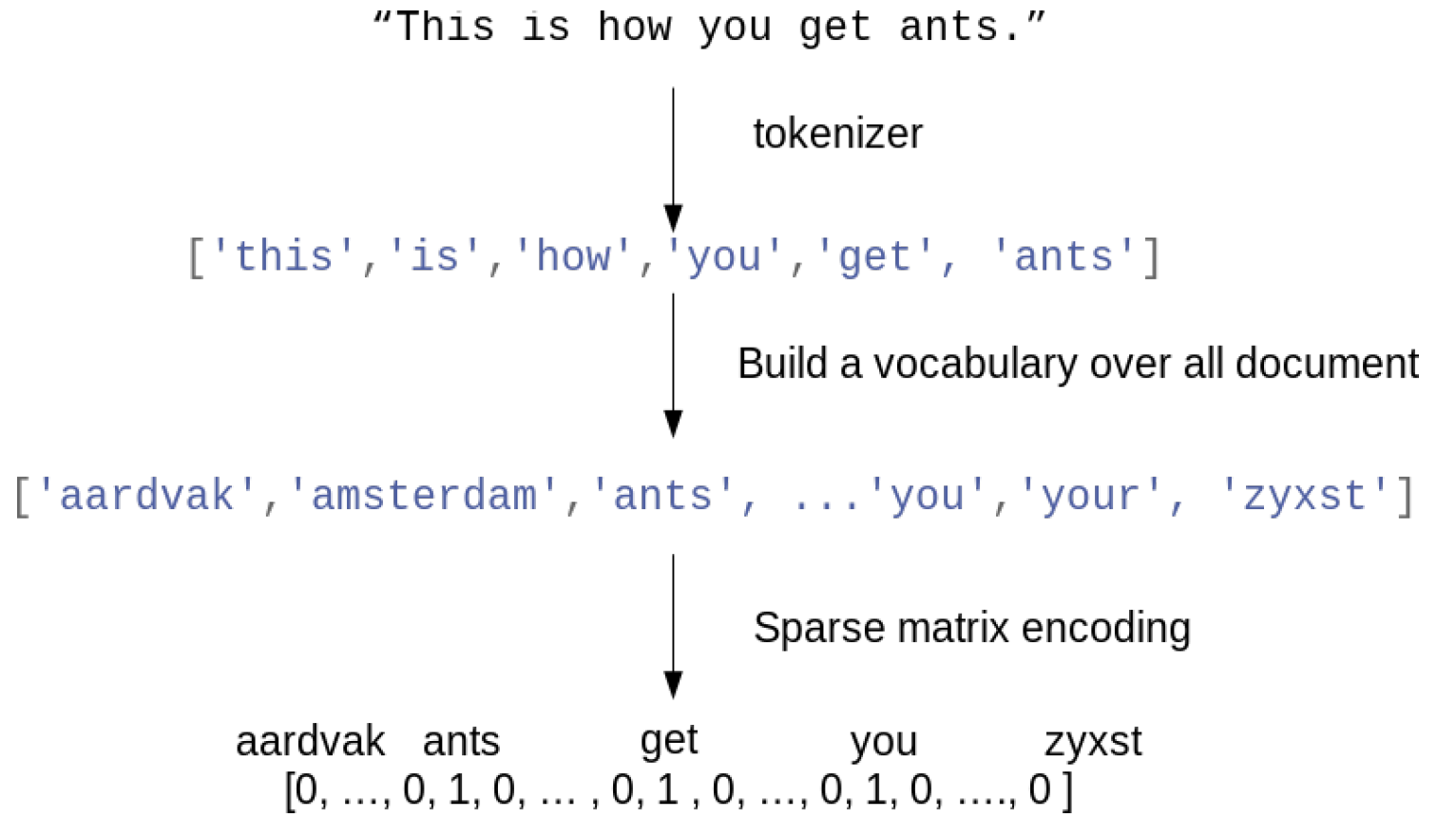
Example: IMBD review database
50,000 reviews, labeled positive (1) or negative (0)
Every row (document) is one review, no other input features
Already tokenized. All markup, punctuation,… removed
from keras.datasets import imdb
word_index = imdb.get_word_index()
print("Text contains {} unique words".format(len(word_index)))
(train_data, train_labels), (test_data, test_labels) = imdb.load_data(index_from=0)
reverse_word_index = dict([(value, key) for (key, value) in word_index.items()])
for r in [0,5,10]:
print("\nReview {}:".format(r),' '.join([reverse_word_index.get(i, '?') for i in train_data[r]][0:50]))
Text contains 88584 unique words
Review 0: the this film was just brilliant casting location scenery story direction everyone's really suited the part they played and you could just imagine being there robert redford's is an amazing actor and now the same being director norman's father came from the same scottish island as myself so i loved
Review 5: the begins better than it ends funny that the russian submarine crew outperforms all other actors it's like those scenes where documentary shots br br spoiler part the message dechifered was contrary to the whole story it just does not mesh br br
Review 10: the french horror cinema has seen something of a revival over the last couple of years with great films such as inside and switchblade romance bursting on to the scene maléfique preceded the revival just slightly but stands head and shoulders over most modern horror titles and is surely one
Bag of words with one-hot-encoding#
Encoded review: shows the list of word IDs. Words are sorted by frequency of occurance.
Allows to easily remove the most common and least common words
One-hot-encoded review: ‘1’ if the word occurs.
Only the first 100 of 10000 values are shown
# Custom implementation of one-hot-encoding.
# dimension is the dimensionality of the output (default 10000).
def vectorize_sequences(sequences, dimension=10000):
results = np.zeros((len(sequences), dimension)) # create empty vector of length N
for i, sequence in enumerate(sequences):
results[i, sequence] = 1. # set specific indices of results[i] to 1s
return results
x_train = vectorize_sequences(train_data, dimension=len(word_index))
x_test = vectorize_sequences(test_data, dimension=len(word_index))
print("Review {}:".format(3),' '.join([reverse_word_index.get(i, '?') for i in train_data[3]][0:80]))
print("\nEncoded review: ", train_data[3][0:80])
print("\nOne-hot-encoded review: ", x_train[3][0:80])
Review 3: the the scots excel at storytelling the traditional sort many years after the event i can still see in my mind's eye an elderly lady my friend's mother retelling the battle of culloden she makes the characters come alive her passion is that of an eye witness one to the events on the sodden heath a mile or so from where she lives br br of course it happened many years before she was born but you wouldn't guess from
Encoded review: [1, 1, 18606, 16082, 30, 2801, 1, 2037, 429, 108, 150, 100, 1, 1491, 10, 67, 128, 64, 8, 58, 15302, 741, 32, 3712, 758, 58, 5763, 449, 9211, 1, 982, 4, 64314, 56, 163, 1, 102, 213, 1236, 38, 1794, 6, 12, 4, 32, 741, 2410, 28, 5, 1, 684, 20, 1, 33926, 7336, 3, 3690, 39, 35, 36, 118, 56, 453, 7, 7, 4, 262, 9, 572, 108, 150, 156, 56, 13, 1444, 18, 22, 583, 479, 36]
One-hot-encoded review: [0. 1. 1. 1. 1. 1. 1. 1. 1. 1. 1. 1. 1. 1. 1. 0. 1. 0. 1. 1. 1. 0. 1. 1.
1. 0. 1. 1. 1. 1. 1. 0. 1. 1. 1. 1. 1. 1. 1. 1. 0. 1. 0. 1. 1. 1. 1. 1.
1. 0. 1. 1. 0. 0. 0. 1. 1. 1. 1. 0. 0. 1. 1. 0. 1. 0. 0. 1. 1. 0. 0. 0.
1. 0. 0. 0. 0. 1. 0. 1.]
Word counts#
Count the number of times each word appears in the document
Example using sklearn
CountVectorizer(on 2 documents)In practice, we also:
Preprocess the text (tokenization, stemming, remove stopwords, …)
Use n-grams (“not terrible”, “terrible acting”,…), character n-grams (‘ter’, ‘err’, ‘eri’,…)
Scale the word-counts (e.g. L2 normalization or TF-IDF)
from sklearn.feature_extraction.text import CountVectorizer
# Fit count vectorizer on a few documents (here: 2)
line = [' '.join([reverse_word_index.get(i, '?') for i in train_data[d]][0:50]) for d in range(2)]
vect = CountVectorizer()
vect.fit(line)
print("Vocabulary (feature names) after fit:", vect.get_feature_names_out())
# Transform the data
# Returns a sparse matrix
X = vect.transform(line)
print("Count encoding doc 1:", X.toarray()[0])
print("Count encoding doc 2:", X.toarray()[1])
Vocabulary (feature names) after fit: ['actor' 'amazing' 'an' 'and' 'are' 'as' 'bad' 'be' 'being' 'best' 'big'
'boobs' 'brilliant' 'but' 'came' 'casting' 'cheesy' 'could' 'describe'
'direction' 'director' 'ever' 'everyone' 'father' 'film' 'from' 'giant'
'got' 'had' 'hair' 'horror' 'hundreds' 'imagine' 'is' 'island' 'just'
'location' 'love' 'loved' 'made' 'movie' 'movies' 'music' 'myself'
'norman' 'now' 'of' 'on' 'paper' 'part' 'pin' 'played' 'plot' 'really'
'redford' 'ridiculous' 'robert' 'safety' 'same' 'scenery' 'scottish'
'seen' 'so' 'story' 'suited' 'terrible' 'the' 'there' 'these' 'they'
'thin' 'this' 'to' 've' 'was' 'words' 'worst' 'you']
Count encoding doc 1: [1 1 1 2 0 1 0 0 2 0 0 0 1 0 1 1 0 1 0 1 1 0 1 1 1 1 0 0 0 0 0 0 1 1 1 2 1
0 1 0 0 0 0 1 1 1 0 0 0 1 0 1 0 1 1 0 1 0 2 1 1 0 1 1 1 0 4 1 0 1 0 1 0 0
1 0 0 1]
Count encoding doc 2: [0 0 0 3 1 0 1 1 0 1 2 1 0 1 0 0 1 0 1 0 0 1 0 0 0 0 1 1 1 1 1 1 0 1 0 0 0
1 0 1 1 1 1 0 0 0 1 1 1 0 1 0 1 0 0 1 0 1 0 0 0 1 0 0 0 1 4 0 1 0 1 2 2 1
0 1 1 0]
Classification#
With this tabular representation, we can fit any model (e.g. Logistic regression)
Visualize coefficients: which words are indicative for positive/negative reviews?
from sklearn.linear_model import LogisticRegressionCV
# Fit CountVectorizer on the first 5000 reviews
data_size = 5000 # You can get a few % better in the full dataset, but takes longer
train_text = [' '.join([reverse_word_index.get(i, '?') for i in train_data[d]]) for d in range(data_size)]
test_text = [' '.join([reverse_word_index.get(i, '?') for i in test_data[d]]) for d in range(data_size)]
vect = CountVectorizer()
train_text_vec = vect.fit_transform(train_text)
test_text_vec = vect.transform(test_text)
lr = LogisticRegressionCV().fit(train_text_vec, train_labels[:data_size])
acc = lr.score(test_text_vec, test_labels[:data_size])
print("Logistic regression accuracy:",acc)
Logistic regression accuracy: 0.8538
def plot_important_features(coef, feature_names, top_n=20, ax=None, rotation=60):
if ax is None:
ax = plt.gca()
inds = np.argsort(coef)
low = inds[:top_n]
high = inds[-top_n:]
important = np.hstack([low, high])
myrange = range(len(important))
colors = ['red'] * top_n + ['blue'] * top_n
ax.bar(myrange, coef[important], color=colors)
ax.set_xticks(myrange)
ax.set_xticklabels(feature_names[important], rotation=rotation, ha="right")
ax.set_xlim(-.7, 2 * top_n)
ax.set_frame_on(False)
plt.figure(figsize=(9*fig_scale, 3.5*fig_scale))
plot_important_features(lr.coef_.ravel(), np.array(vect.get_feature_names_out()), top_n=20, rotation=40)
ax = plt.gca()
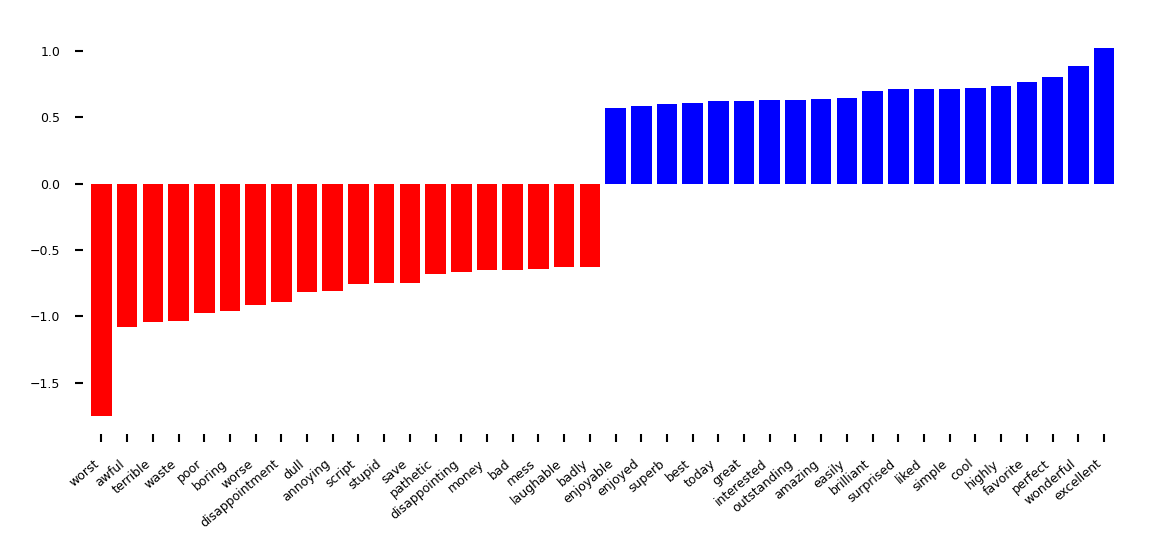
Preprocessing#
Tokenization: how to you split text into words? On spaces only? Also -, ` ?
Stemming: naive reduction to word stems. E.g. ‘the meeting’ to ‘the meet’
Lemmatization: smarter reduction (NLP-based). E.g. distinguishes between nouns and verbs
Discard stop words (‘the’, ‘an’,…)
Only use \(N\) (e.g. 10000) most frequent words
Or, use a hash function (risks collisions)
n-grams: Use combinations of \(n\) adjacent words next to individual words
e.g. 2-grams: “awesome movie”, “movie with”, “with creative”, …
Character n-grams: combinations of \(n\) adjacent letters: ‘awe’, ‘wes’, ‘eso’,…
Scaling#
L2 Normalization (vector norm): sum of squares of all word values equals 1
Normalized Euclidean distance is equivalent to cosine distance
Works better for distance-based models (e.g. kNN, SVM,…) $\( t_i = \frac{t_i}{\| t\|_2 }\)$
Term Frequency - Inverted Document Frequency (TF-IDF)
Scales value of words by how frequently they occur across all \(N\) documents
Words that only occur in few documents get higher weight, and vice versa
Usually done in preprocessing, e.g. sklearn
NormalizerorTfidfTransformerL2 normalization can also be done in a
Lambdalayer
model.add(Lambda(lambda x: tf.linalg.normalize(x,axis=1)))
Neural networks on bag of words#
We can also build neural networks on bag-of-word vectors
E.g. Use one-hot-encoding with 10000 most frequent words
Simple model with 2 dense layers, ReLU activation, dropout
Binary classification: single output node, sigmoid activation, binary cross-entropy loss
model.add(layers.Dense(16, activation='relu', input_shape=(10000,)))
model.add(layers.Dropout(0.5))
model.add(layers.Dense(16, activation='relu'))
model.add(layers.Dropout(0.5))
model.add(layers.Dense(1, activation='sigmoid'))
model.compile(optimizer='rmsprop', loss='binary_crossentropy', metrics=['accuracy'])
# Load data with 10000 words
(train_data, train_labels), (test_data, test_labels) = imdb.load_data(num_words=10000)
# One-hot-encoding
x_train = vectorize_sequences(train_data)
x_test = vectorize_sequences(test_data)
# Convert 0/1 labels to float
y_train = np.asarray(train_labels).astype('float32')
y_test = np.asarray(test_labels).astype('float32')
# Callback for plotting
# TODO: move this to a helper file
from tensorflow.keras.callbacks import Callback
from IPython.display import clear_output
# For plotting the learning curve in real time
class TrainingPlot(Callback):
# This function is called when the training begins
def on_train_begin(self, logs={}):
# Initialize the lists for holding the logs, losses and accuracies
self.losses = []
self.acc = []
self.val_losses = []
self.val_acc = []
self.logs = []
self.max_acc = 0
# This function is called at the end of each epoch
def on_epoch_end(self, epoch, logs={}):
# Append the logs, losses and accuracies to the lists
self.logs.append(logs)
self.losses.append(logs.get('loss'))
self.acc.append(logs.get('accuracy'))
self.val_losses.append(logs.get('val_loss'))
self.val_acc.append(logs.get('val_accuracy'))
self.max_acc = max(self.max_acc, logs.get('val_accuracy'))
# Before plotting ensure at least 2 epochs have passed
if len(self.losses) > 1:
# Clear the previous plot
clear_output(wait=True)
N = np.arange(0, len(self.losses))
# Plot train loss, train acc, val loss and val acc against epochs passed
plt.figure(figsize=(8*fig_scale,3*fig_scale))
plt.plot(N, self.losses, lw=2, c="b", linestyle="-", label = "train_loss")
plt.plot(N, self.acc, lw=2, c="r", linestyle="-", label = "train_acc")
plt.plot(N, self.val_losses, lw=2, c="b", linestyle=":", label = "val_loss")
plt.plot(N, self.val_acc, lw=2, c="r", linestyle=":", label = "val_acc")
plt.title("Training Loss and Accuracy [Epoch {}, Max Acc {:.4f}]".format(epoch, self.max_acc))
plt.xlabel("Epoch #")
plt.ylabel("Loss/Accuracy")
plt.legend()
plt.show()
plot_losses = TrainingPlot()
Evaluation#
Take a validation set of 10,000 samples from the training set
The validation loss peaks after a few epochs, after which the model starts to overfit
Performance is better than Logistic regression
from tensorflow.keras import models
from tensorflow.keras import layers
x_val, partial_x_train = x_train[:10000], x_train[10000:]
y_val, partial_y_train = y_train[:10000], y_train[10000:]
model = models.Sequential()
model.add(layers.Dense(16, activation='relu', input_shape=(10000,)))
model.add(layers.Dropout(0.5))
model.add(layers.Dense(16, activation='relu'))
model.add(layers.Dropout(0.5))
model.add(layers.Dense(1, activation='sigmoid'))
model.compile(optimizer='rmsprop', loss='binary_crossentropy', metrics=['accuracy'])
history = model.fit(partial_x_train, partial_y_train,
epochs=15, batch_size=512, verbose=0,
validation_data=(x_val, y_val), callbacks=[plot_losses])

Predictions#
Let’s look at a few predictions:
predictions = model.predict(x_test)
print("Review 0: ", ' '.join([reverse_word_index.get(i - 3, '?') for i in test_data[0]]))
print("Predicted positiveness: ", predictions[0])
print("\nReview 16: ", ' '.join([reverse_word_index.get(i - 3, '?') for i in test_data[16]]))
print("Predicted positiveness: ", predictions[16])
782/782 [==============================] - 2s 2ms/step
Review 0: ? please give this one a miss br br ? ? and the rest of the cast rendered terrible performances the show is flat flat flat br br i don't know how michael madison could have allowed this one on his plate he almost seemed to know this wasn't going to work out and his performance was quite ? so all you madison fans give this a miss
Predicted positiveness: [0.045]
Review 16: ? from 1996 first i watched this movie i feel never reach the end of my satisfaction i feel that i want to watch more and more until now my god i don't believe it was ten years ago and i can believe that i almost remember every word of the dialogues i love this movie and i love this novel absolutely perfection i love willem ? he has a strange voice to spell the words black night and i always say it for many times never being bored i love the music of it's so much made me come into another world deep in my heart anyone can feel what i feel and anyone could make the movie like this i don't believe so thanks thanks
Predicted positiveness: [0.816]
Word Embeddings#
A word embedding is a numeric vector representation of a word
Can be manual or learned from an existing representation (e.g. one-hot)
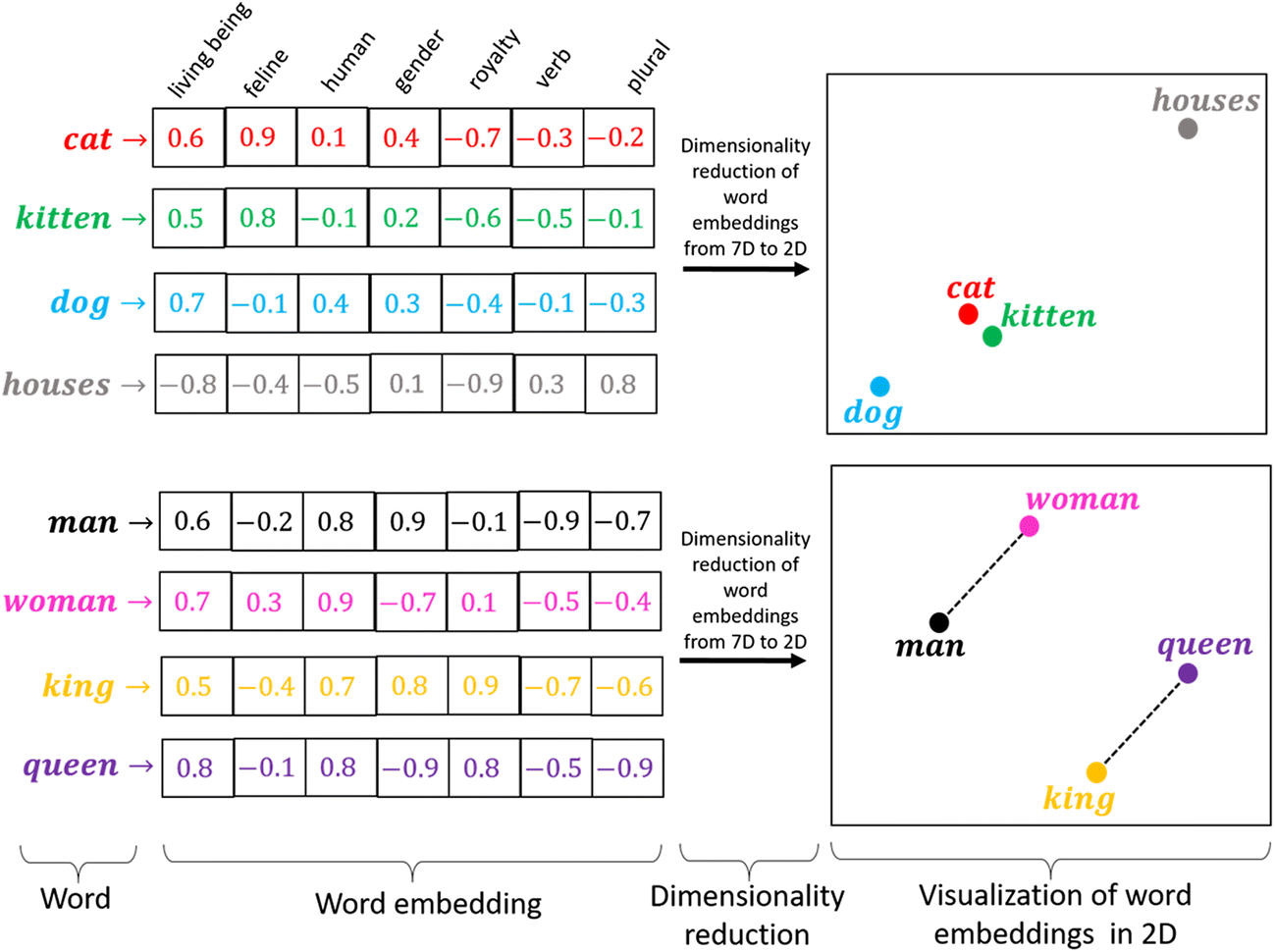
Learning embeddings from scratch#
Input layer uses fixed length documents (with 0-padding). 2D tensor (samples, max_length)
Add an embedding layer to learn the embedding
Create \(n\)-dimensional one-hot encoding. Yields a 3D tensor (samples, max_length, \(n\))
To learn an \(m\)-dimensional embedding, use \(m\) hidden nodes. Weight matrix \(W^{n x m}\)
Linear activation function: \(\mathbf{X}_{embed} = W \mathbf{X}_{orig}\). 3D tensor (samples, max_length, \(m\))
Combine all word embeddings into a document embedding (e.g. global pooling).
Add (optional) layers to map word embeddings to the output. Learn embedding weights from data.
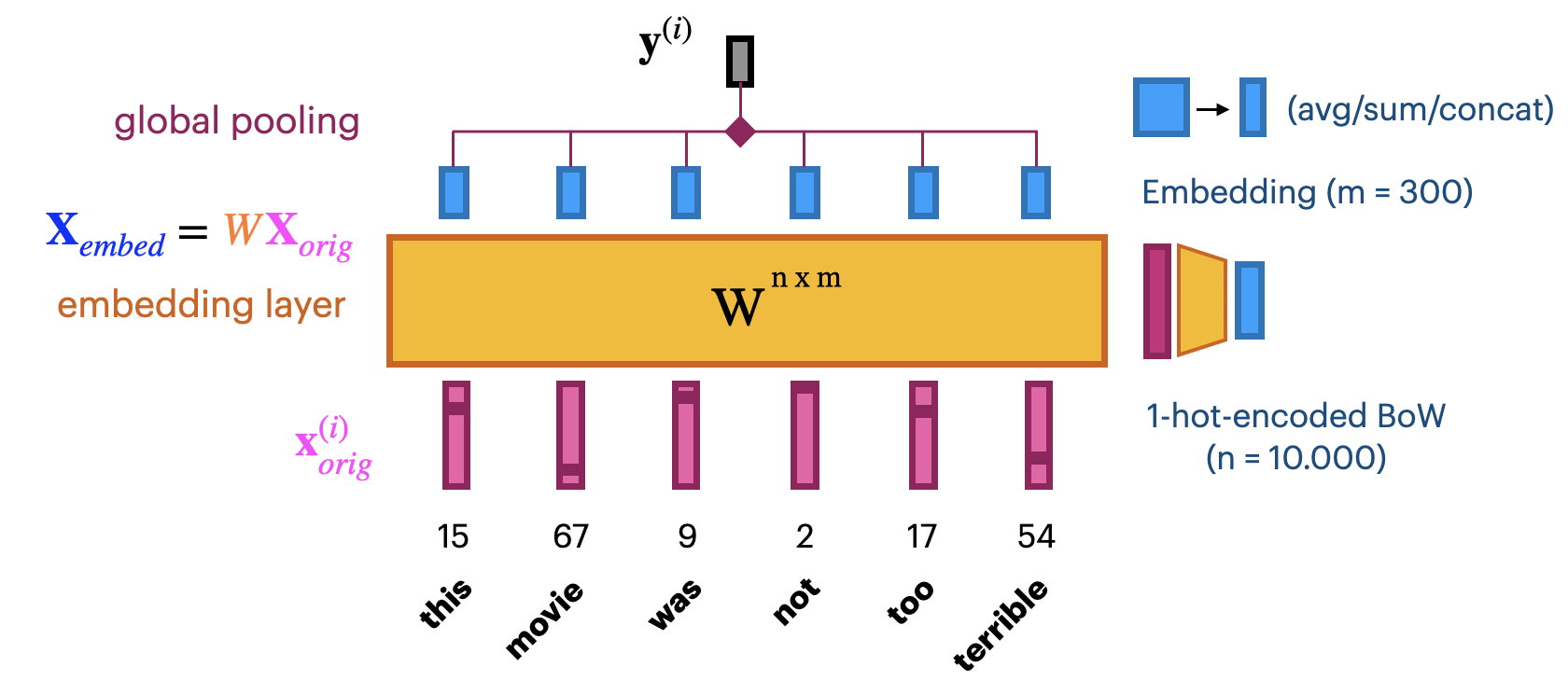
Let’s try this:
max_length = 100 # pad documents to a maximum number of words
vocab_size = 10000 # vocabulary size
embedding_length = 20 # embedding length (more would be better)
model = models.Sequential()
model.add(layers.Embedding(vocab_size, embedding_length, input_length=max_length))
model.add(layers.GlobalAveragePooling1D())
model.add(layers.Dense(1, activation='sigmoid'))
max_length = 100 # pad documents to a maximum number of words
vocab_size = 10000 # vocabulary size
embedding_length = 20 # embedding length
# define the model
model = models.Sequential()
model.add(layers.Embedding(vocab_size, embedding_length, input_length=max_length))
model.add(layers.GlobalAveragePooling1D())
model.add(layers.Dense(1, activation='sigmoid'))
model.compile(optimizer='rmsprop', loss='binary_crossentropy', metrics=['accuracy'])
# summarize the model
model.summary()
Model: "sequential_1"
_________________________________________________________________
Layer (type) Output Shape Param #
=================================================================
embedding (Embedding) (None, 100, 20) 200000
global_average_pooling1d (G (None, 20) 0
lobalAveragePooling1D)
dense_3 (Dense) (None, 1) 21
=================================================================
Total params: 200,021
Trainable params: 200,021
Non-trainable params: 0
_________________________________________________________________
Training on the IMDB dataset: slightly worse than using bag-of-words?
Embedding of dim 20 is very small, should be closer to 100 (or 300)
We don’t have enough data to learn a really good embedding from scratch
from keras.utils import pad_sequences
# Load reviews again
(x_train, y_train), (x_test, y_test) = imdb.load_data(num_words=10000)
# Turn word ID's into a 2D integer tensor of shape `(samples, maxlen)`
x_train = pad_sequences(x_train, maxlen=max_length)
x_test = pad_sequences(x_test, maxlen=max_length)
model.fit(x_train, y_train, epochs=10, verbose=0,
batch_size=32, validation_split=0.2, callbacks=[plot_losses]);

Pre-trained embeddings#
With more data we can build better embeddings, but we also need more labels
Solution: learn embedding on auxiliary task that doesn’t require labels
E.g. given a word, predict the surrounding words.
Also called self-supervised learning. Supervision is provided by data itself
Freeze embedding weights to produce simple word embeddings, or finetune to a new tasks
Most common approaches:
Word2Vec: Learn neural embedding for a word based on surrounding words
FastText: learns embedding for character n-grams
Can also produce embeddings for new, unseen words
GloVe (Global Vector): Count co-occurrences of words in a matrix
Use a low-rank approximation to get a latent vector representation
Word2Vec#
Move a window over text to get \(C\) context words (\(V\)-dim one-hot encoded)
Add embedding layer with \(N\) linear nodes, global average pooling, and softmax layer(s)
CBOW: predict word given context, use weights of last layer \(W^{'}_{NxV}\) as embedding
Skip-Gram: predict context given word, use weights of first layer \(W^{T}_{VxN}\) as embedding
Scales to larger text corpora, learns relationships between words better
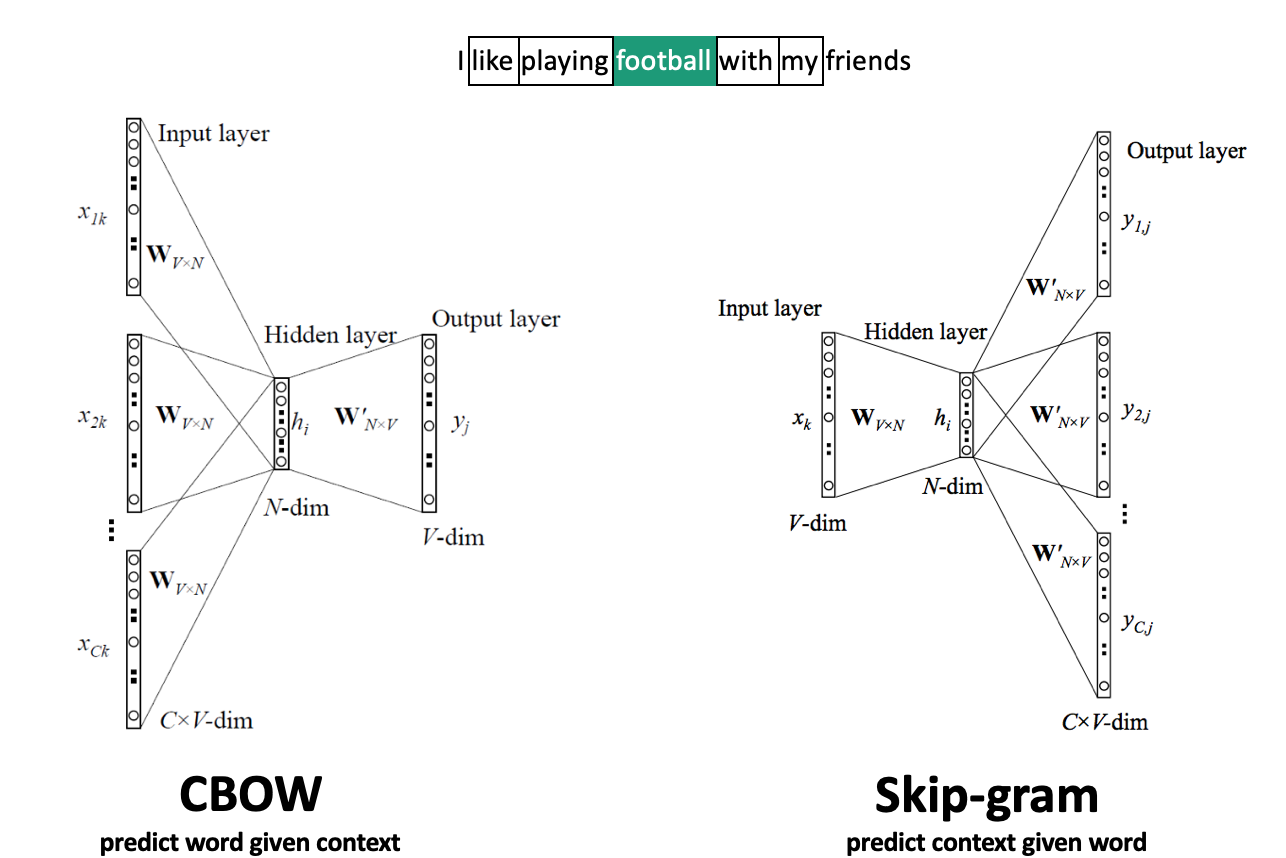
Word2Vec properties#
Word2Vec happens to learn interesting relationships between words
Simple vector arithmetic can map words to plurals, conjugations, gender analogies,…
e.g. Gender relationships: \(vec_{king} - vec_{man} + vec_{woman} \sim vec_{queen}\)
PCA applied to embeddings shows Country - Capital relationship
Careful: embeddings can capture gender and other biases present in the data.
Important unsolved problem!
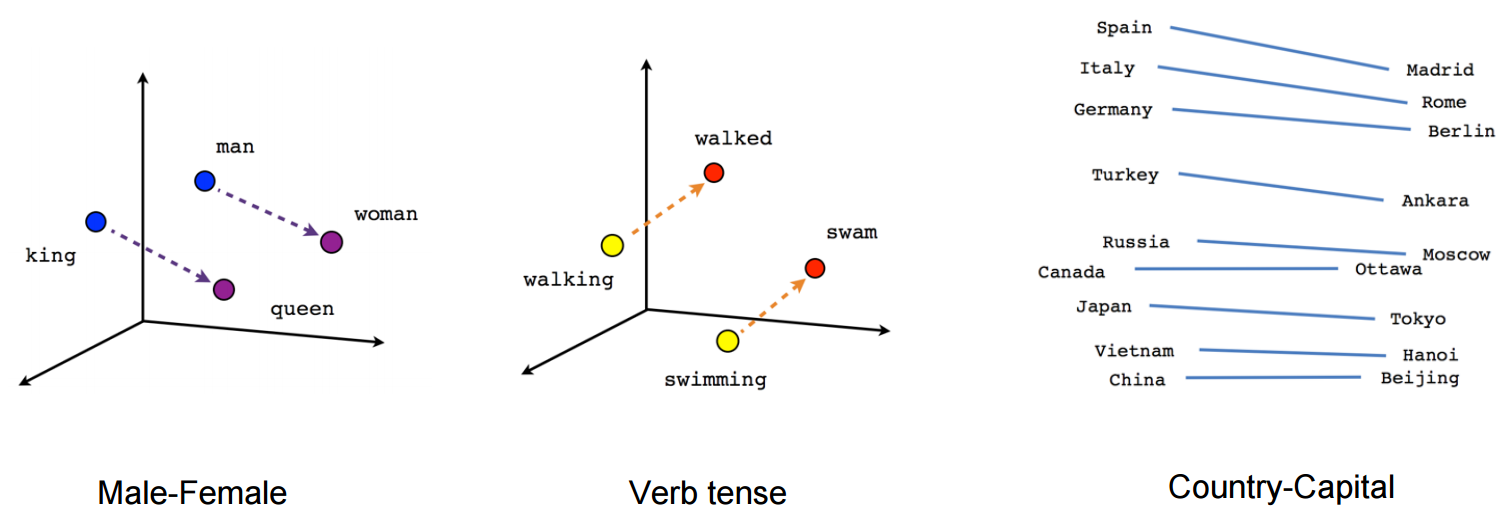
Doc2Vec#
Alternative way to combine word embeddings (instead of global pooling)
Adds a paragraph (or document) embedding: learns how paragraphs (or docs) relate to each other
Captures document-level semantics: context and meaning of entire document
Can be used to determine semantic similarity between documents.

FastText#
Limitations of Word2Vec:
Cannot represent new (out-of-vocabulary) words
Similar words are learned independently: less efficient (no parameter sharing)
E.g. ‘meet’ and ‘meeting’
FastText: same model, but uses character n-grams
Words are represented by all character n-grams of length 3 to 6
“football” 3-grams: <fo, foo, oot, otb, tba, bal, all, ll>
Because there are so many n-grams, they are hashed (dimensionality = bin size)
Representation of word “football” is sum of its n-gram embeddings
Negative sampling: also trains on random negative examples (out-of-context words)
Weights are updated so that they are less likely to be predicted
Global Vector model (GloVe)#
Builds a co-occurence matrix \(\mathbf{X}\): counts how often 2 words occur in the same context
Learns a k-dimensional embedding \(W\) through matrix factorization with rank k
Actually learns 2 embeddings \(W\) and \(W'\) (differ in random initialization)
Minimizes loss \(\mathcal{L}\), where \(b_i\) and \(b'_i\) are bias terms and \(f\) is a weighting function
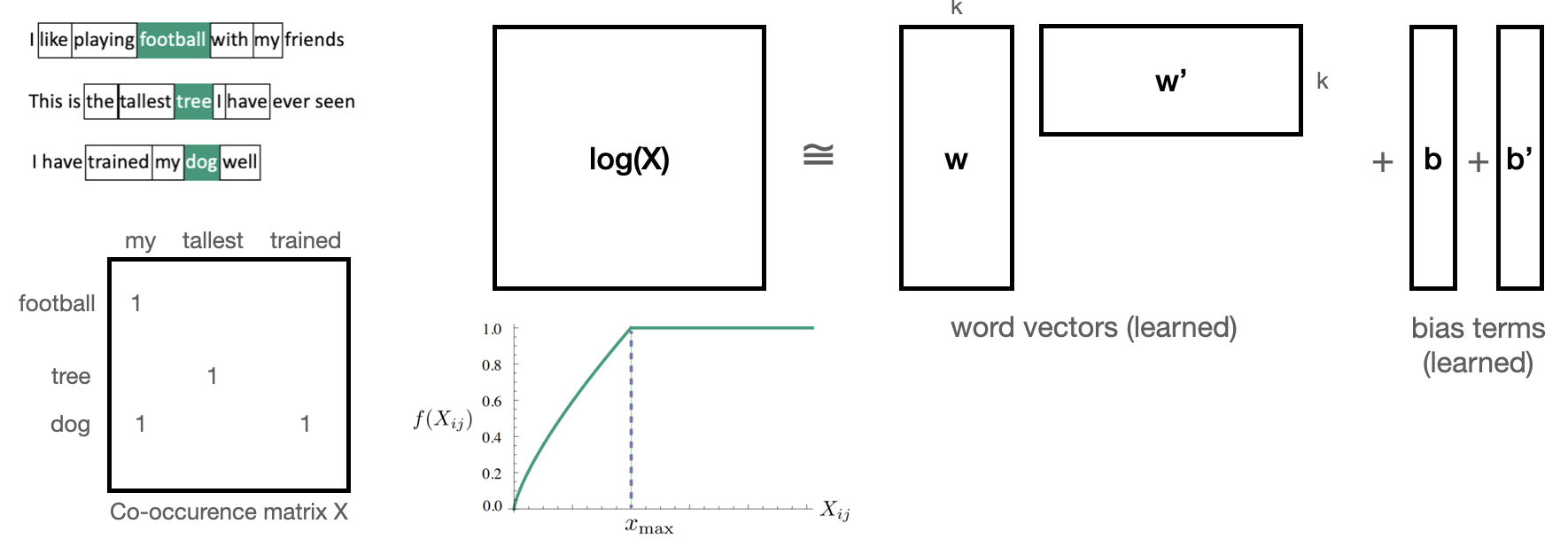
Let’s try this
Download the GloVe embeddings trained on Wikipedia
We can now get embeddings for 400,000 English words
E.g. ‘queen’ (in 100-dim):
# To find the original data files, see
# http://nlp.stanford.edu/data/glove.6B.zip
# http://www.cs.cmu.edu/afs/cs.cmu.edu/project/theo-20/www/data/news20.tar.gz
import tarfile
import gdown
data_dir = '../data'
if not os.path.exists(os.path.join(data_dir,"glove.txt")):
# Download GloVe embedding
url = 'https://drive.google.com/uc?id=1ZOd5P9kreaBYg5Oh2n5McC-BozYcsKIH'
output = os.path.join(data_dir,"glove.txt")
gdown.download(url, output, quiet=False)
# Build an index so that we can later easily compose the embedding matrix
embeddings_index = {}
with open(os.path.join(data_dir, 'glove.txt')) as f:
for line in f:
word, coefs = line.split(maxsplit=1)
coefs = np.fromstring(coefs, "f", sep=" ")
embeddings_index[word] = coefs
print('Found %s word vectors.' % len(embeddings_index))
Found 400000 word vectors.
embeddings_index['queen']
array([-0.5 , -0.708, 0.554, 0.673, 0.225, 0.603, -0.262, 0.739,
-0.654, -0.216, -0.338, 0.245, -0.515, 0.857, -0.372, -0.588,
0.306, -0.307, -0.219, 0.784, -0.619, -0.549, 0.431, -0.027,
0.976, 0.462, 0.115, -0.998, 1.066, -0.208, 0.532, 0.409,
1.041, 0.249, 0.187, 0.415, -0.954, 0.368, -0.379, -0.68 ,
-0.146, -0.201, 0.171, -0.557, 0.719, 0.07 , -0.236, 0.495,
1.158, -0.051, 0.257, -0.091, 1.266, 1.105, -0.516, -2.003,
-0.648, 0.164, 0.329, 0.048, 0.19 , 0.661, 0.081, 0.336,
0.228, 0.146, -0.51 , 0.638, 0.473, -0.328, 0.084, -0.785,
0.099, 0.039, 0.279, 0.117, 0.579, 0.044, -0.16 , -0.353,
-0.049, -0.325, 1.498, 0.581, -1.132, -0.607, -0.375, -1.181,
0.801, -0.5 , -0.166, -0.706, 0.43 , 0.511, -0.803, -0.666,
-0.637, -0.36 , 0.133, -0.561], dtype=float32)
Same simple model, but with frozen GloVe embeddings: much worse!
embedding_layer = layers.Embedding(input_dim=10000, output_dim=100,
input_length=max_length, trainable=False)
embedding_layer.set_weights([weights]) # set pre-trained weigths
model = models.Sequential([
embedding_layer, layers.GlobalAveragePooling1D(),
layers.Dense(1, activation='sigmoid')]
embedding_dim = 100
# Create embedding layer
embedding_layer = layers.Embedding(input_dim=10000,
output_dim=embedding_dim,
input_length=max_length,
trainable=False)
# define the model
model = models.Sequential()
model.add(embedding_layer)
model.add(layers.GlobalAveragePooling1D())
model.add(layers.Dense(1, activation='sigmoid'))
# Set pre-trained GloVe weights for the embedding layer
weights = np.zeros((10000, embedding_dim))
cnt = 0
for word, i in word_index.items():
if i < 10000:
embedding_vector = embeddings_index.get(word)
if embedding_vector is not None:
weights[i] = embedding_vector
else:
cnt += 1
print(cnt, "unknown words")
embedding_layer.set_weights([weights])
# Compile
model.compile(optimizer='adam', loss='binary_crossentropy', metrics=['accuracy'])
# Train
model.fit(x_train, y_train, epochs=20, verbose=0,
batch_size=32, validation_split=0.2, callbacks=[plot_losses]);
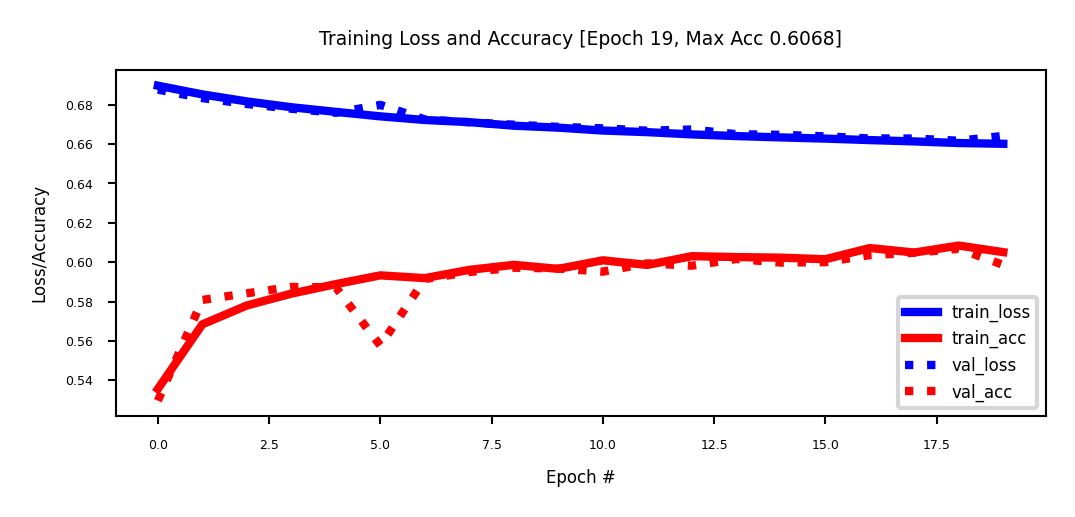
Sequence-to-sequence (seq2seq) models#
Global average pooling or flattening destroys the word order
We need to model sequences explictly, e.g.:
1D convolutional models: run a 1D filter over the input data
Fast, but can only look at small part of the sentence
Recurrent neural networks (RNNs)
Can look back at the entire previous sequence
Much slower to train, have limited memory in practice
Attention-based networks (Transformers)
Best of both worlds: fast and very long memory
seq2seq models#
Produce a series of output given a series of inputs over time
Can handle sequences of different lengths
Label-to-sequence, Sequence-to-label, seq2seq,…
Autoregressive models (e.g. predict the next character, unsupervised)
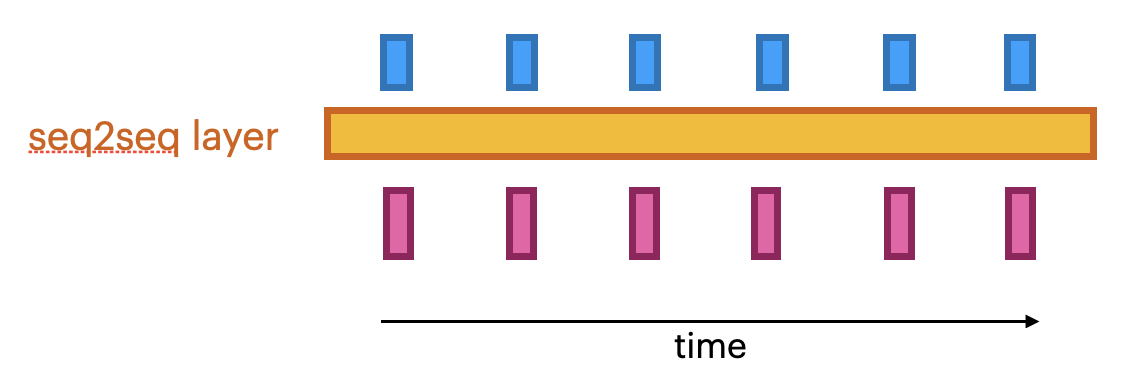
1D convolutional networks#
Similar to 2D convnets, but moves only in 1 direction (time)
Extract local 1D patch, apply filter (kernel) to every patch
Pattern learned can later be recognized elsewhere (translation invariance)
Limited memory: only sees a small part of the sequence (receptive field)
You can use multiple layers, dilations,… but becomes expensive
Looks at ‘future’ parts of the series, but can be made to look only at the past
Known as ‘causal’ models (not related to causality)

Same embedding, but add 2
Conv1Dlayers andMaxPooling1D. Better!
model = models.Sequential([
embedding_layer,
layers.Conv1D(32, 7, activation='relu'),
layers.MaxPooling1D(5),
layers.Conv1D(32, 7, activation='relu'),
layers.GlobalAveragePooling1D(),
layers.Dense(1, activation='sigmoid')]
model = models.Sequential()
model.add(layers.Embedding(max_words, 128, input_length=max_length))
model.add(layers.Conv1D(32, 7, activation='relu'))
model.add(layers.MaxPooling1D(5))
model.add(layers.Conv1D(32, 7, activation='relu'))
model.add(layers.GlobalMaxPooling1D())
model.add(layers.Dense(1))
model.compile(optimizer="rmsprop",
loss='binary_crossentropy',
metrics=['accuracy'])
history = model.fit(x_train, y_train,
epochs=10,
batch_size=128,
validation_split=0.2,
callbacks=[plot_losses])
---------------------------------------------------------------------------
NameError Traceback (most recent call last)
Cell In[18], line 2
1 model = models.Sequential()
----> 2 model.add(layers.Embedding(max_words, 128, input_length=max_length))
3 model.add(layers.Conv1D(32, 7, activation='relu'))
4 model.add(layers.MaxPooling1D(5))
NameError: name 'max_words' is not defined
Recurrent neural networks (RNNs)#
Adds a recurrent connection that concats previous output to next input \({\color{orange} h_t} = \sigma \left( {\color{orange} W } \left[ \begin{array}{c} {\color{blue}x}_t \\ {\color{orange} h}_{t-1} \end{array} \right] + b \right)\)
Unbounded memory, but training requires backpropagation through time
Requires storing previous network states (slow + lots of memory)
Vanishing gradients strongly limit practical memory
Improved with gating: learn what to input, forget, output (LSTMs, GRUs,…)
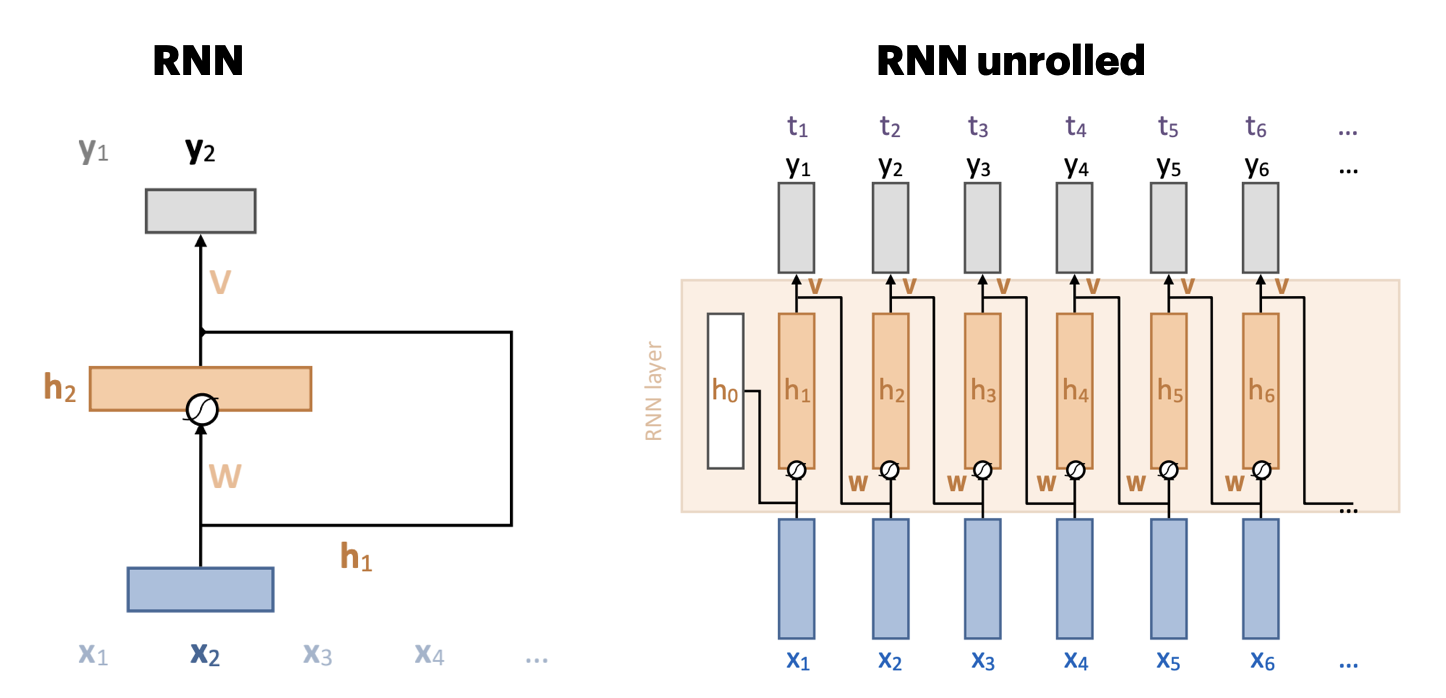
Simple self-attention#
Compute dot product of input vector \(x_i\) with every \(x_j\) (including itself): \({\color{Orange} w_{ij}}\)
Compute softmax over all these weights (positive, sum to 1)
Multiply by each input vector, and sum everything up
Can be easily vectorized: \({\color{green} Y}^T = {\color{orange} W}{\color{blue} X^T}\), \({\color{orange} W} = \textrm{softmax}( {\color{blue} X}^T {\color{blue}X} )\)
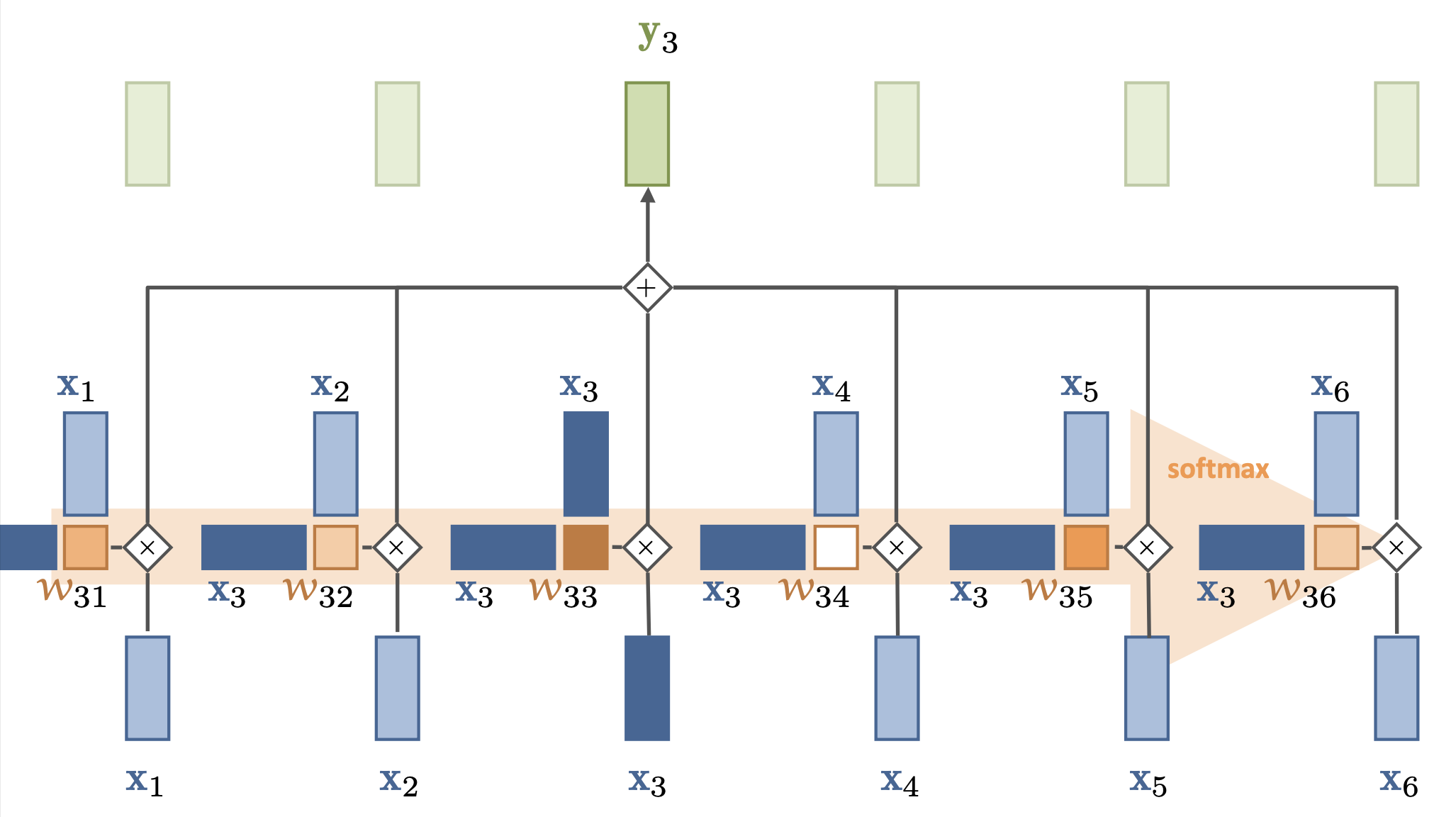
Simple self-attention (2)#
Output is mostly influenced by the current input (\({\color{Orange} w_{ii}}\) is largest)
Mixes in information from other inputs according to how similar they are
Doesn’t learn (no parameters), the embedding of \({\color{blue} X}\) defines self-attention
\({\color{green} Y}^T = {\color{orange} W}{\color{blue} X^T}\) is linear, vanishing gradients only through softmax
Has no problem looking very far back in the sequence
Operates on sets (permutation invariant): allows img-to-set, set-to-set,… tasks
No access to sequence. For seq tasks we encode sequence in embedding

Simple self-attention layer#
Let’s add a simple self-attention layer to our movie sentiment model
Without self-attention, every word would contribute independently from others
Exactly as in a bag-of-words model
The word terrible will likely result in a negative prediction

Simple self-attention layer#
Self-attention can learn that the meaning on the word terrible is inverted by the presence of the word not, even if it is further away in the sequence.
In general, each self attention layer can learn specific relationships between words (e.g. inversion). We’ll need many of them.
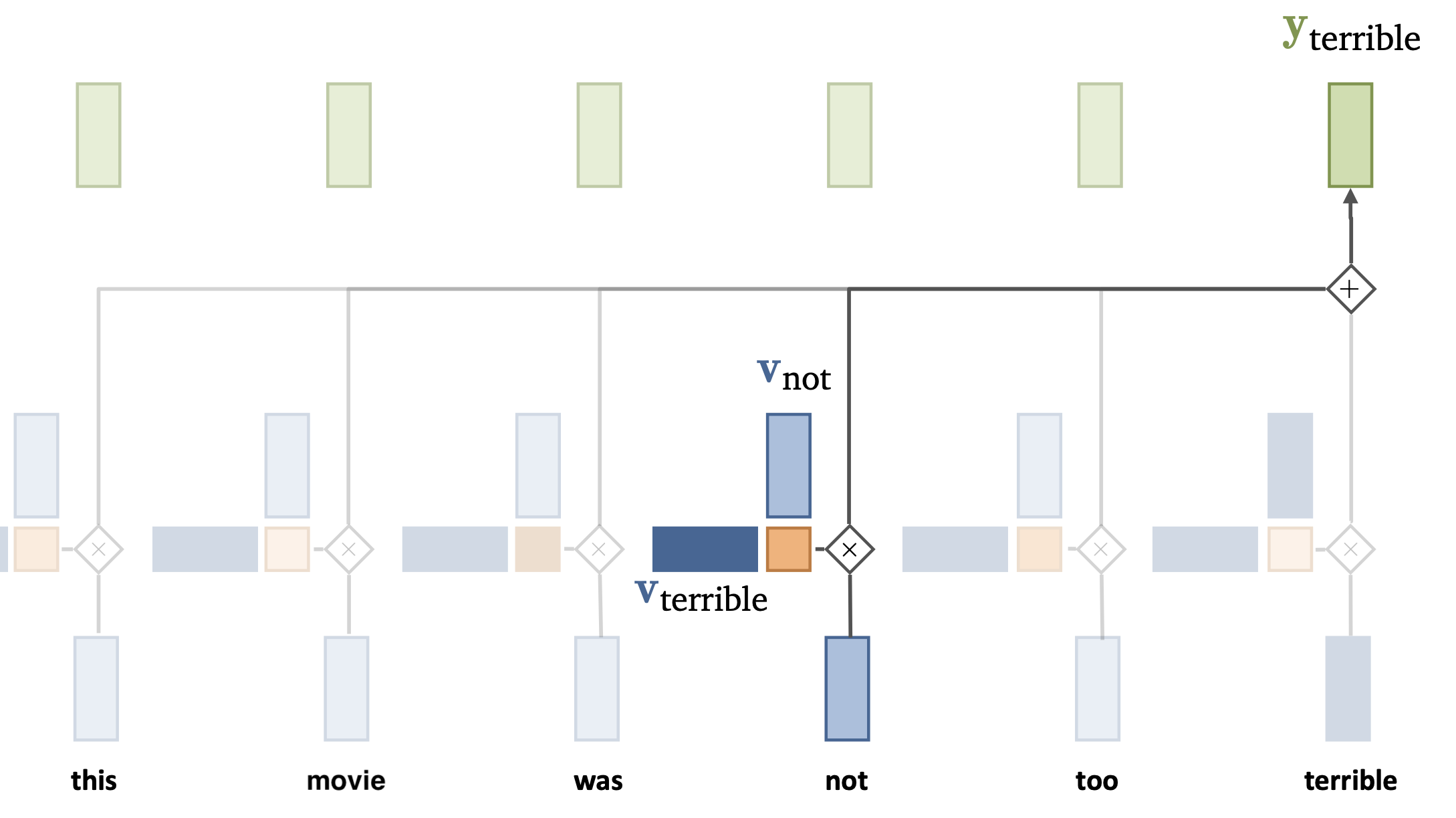
Standard self-attention#
Inputs occur in one of 3 positions in the self-attention layer:
Value \(v\): input vector that provides the output, weighted by:
Query \(q\): the vector that corresponds to the wanted output
Key \(k\): The vector that the query is matched aganinst
Works as a soft version of a dictionary, in which:
Every key matches the query to some extent (w.r.t. its dot product)
A weighted mixture of all values (normalized by softmax)
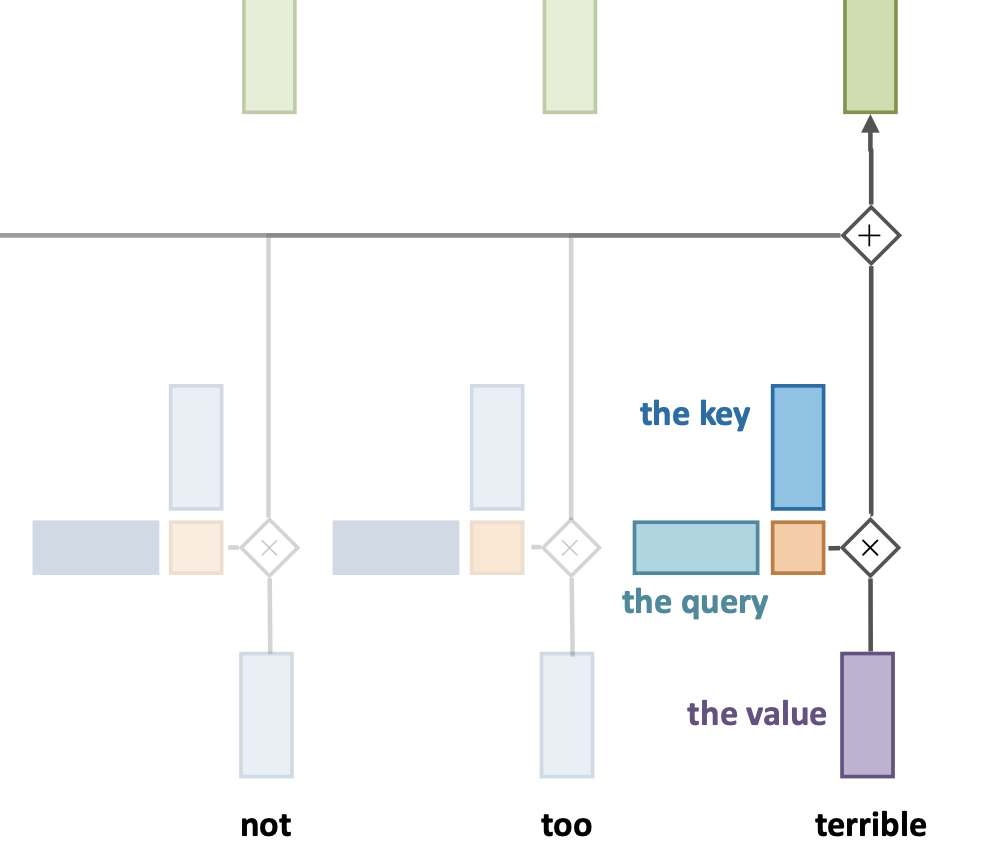
Standard self-attention#
We want to learn how each of these interact by adding learned transformations
\(k_i = K x_i + b_k\)
\(q_i = Q x_i + b_q\)
\(v_i = V x_i + b_v\)
Makes self-attention more flexible, learnable
Learn what to pay attention to in the input (e.g. sequence, image,…)
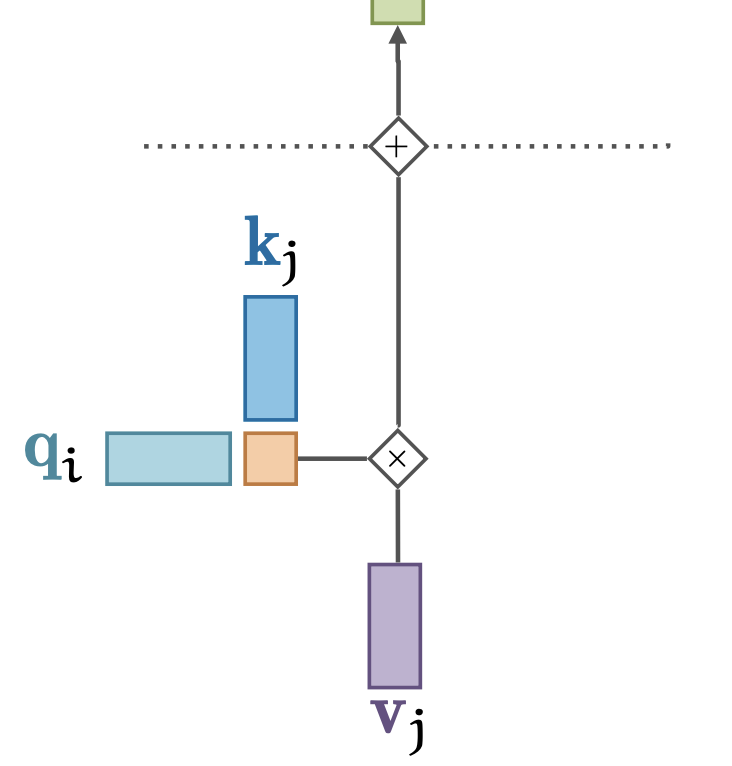
Standard self-attention (2)#
Inputs can have multiple relationships with each other (e.g. negation, strengtening,…)
To learn these in parallel, we can split the self-attention in multiple heads
Input vector is embedded (linearly) into lower dimensionality, multiple times
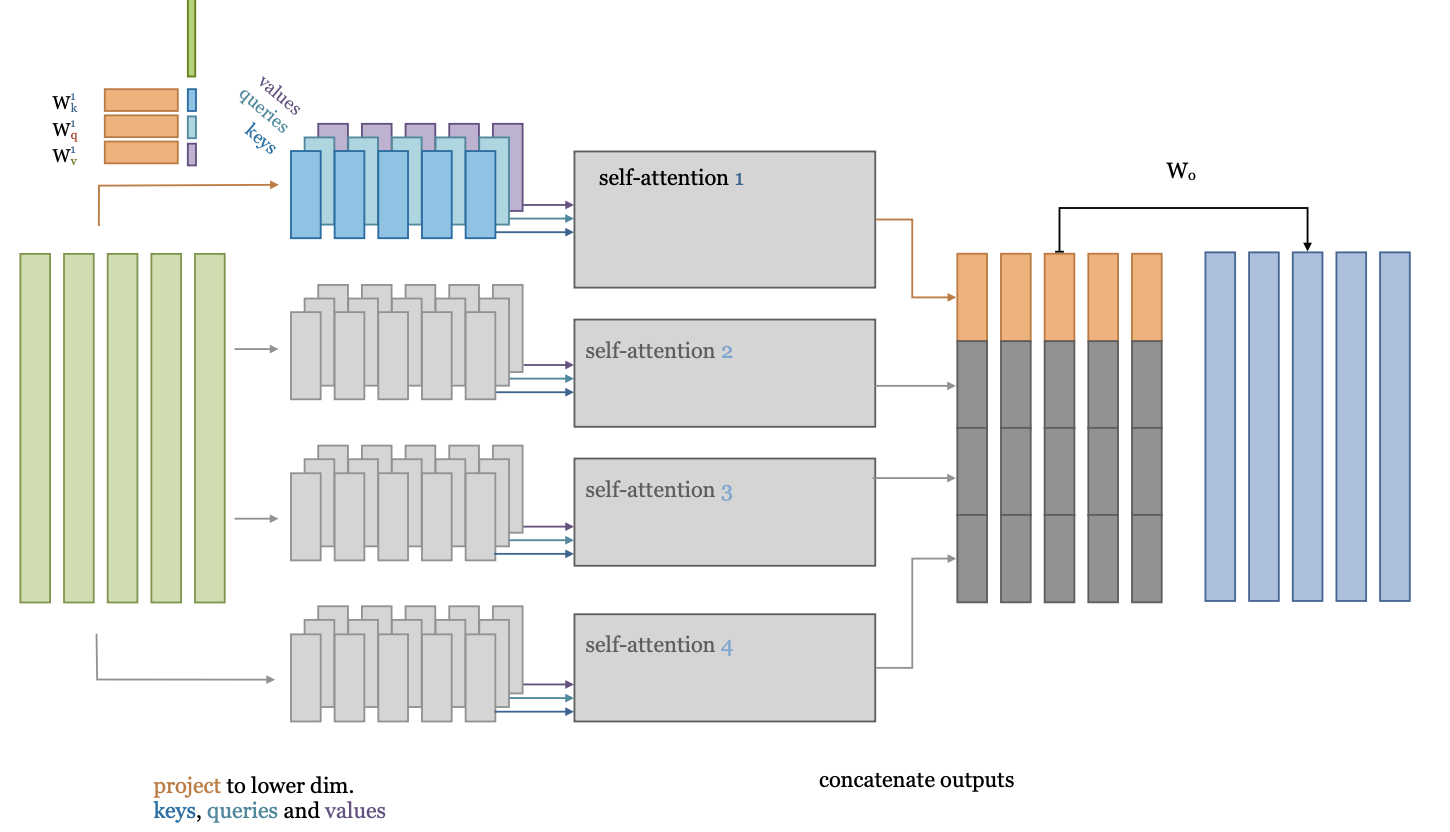
Standard self-attention (3)#
The softmax operation can still lead to vanishing gradients (unless values are small)
We can scale the dot product by the input dimension \(k\): \({\color{orange}w^{'}_{ij}} = \frac{{\color{blue} x_i}^T \color{blue} x_j}{\sqrt{k}}\)
Transformer model#
Repeat self-attention multiple times in controlled fashion
Works for sequences, images, graphs,… (learn how sets of objects interact)
Models consist of multiple transformer blocks, usually:
Layer normalization (every input is normalized independently)
Self-attention layer (learn interactions)
Residual connections (preserve gradients in deep networks)
Feed-forward layer (learn mappings)

Positional encoding#
We need some way to tell the self-attention layer about position in the sequence
Represent position by vectors, using some easy-to-learn predictable pattern
Add these encodings to vector embeddings
Givee information on how far one input is from the others

Summary#
Bag of words representations
Useful, but limited, since they destroy the order of the words in text
Word embeddings
Learning word embeddings from labeled data is hard, you may need a lot of data
Pretrained word embeddings
Word2Vec: learns good embeddings and interesting relationships
FastText: can also compute embeddings for entirely new words
GloVe: also takes the global context of words into account
Sequence-to-sequence models
1D convolutional nets (fast, limited memory)
RNNs (slow, also quite limited memory)
Self-attention (allows very large memory)
Transformers
Acknowledgement
Several figures came from the excellent VU Deep Learning course

